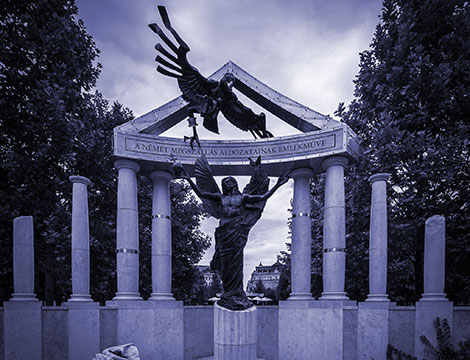
This article was originally published by the World Policy Institute on 12 July 2016
In March 2014, Budapest’s Liberty Square became home to the newest controversial monument in the city. The now-notorious German occupation monument consists of two parts: an angel and an eagle. In the middle of ivory columns lined up in a wedge, Archangel Gabriel stands with his arms wide open. His right hand is holding a golden orb, an element of the Hungarian royal insignia. His eyes are gracefully closed, as if he is fully aware of his destiny. A giant, pitch-black eagle—the symbol of Imperial Germany—ominously flies overhead. Its three-pronged claw swings as if it will snatch the orb from the angel’s hand.
Immediately after its construction, the monument was met with fierce criticism from home and abroad. Civil organizations denounced the Hungarian government, saying it was “falsifying the Holocaust” by erecting a monument that glosses over Hungary’s collusion with the Nazis. The monument comes as another expression of surging nationalism in the country, which the current government has stoked by granting voting rights to foreigners based on their Hungarian ethnicity, disseminating anti-immigrant questionnaires filled with leading questions, building fences along the country’s borders with Serbia and Croatia to block the influx of refugees, and making openly xenophobic statements against non-Christian migrants.
Indeed, the monument is a poor representation of the German-Hungarian relations during World War II. But even worse, the monument fails to perform the most important function of memorials, which is to create an intellectual and psychological space for the public to reflect upon history. Instead, it purposefully induces anger and nationalism, risking the danger of promoting simplistic and skewed understanding of history.
The role of Hungary in WWII was far from that of a simple victim. Before the war started, the build-up of anti-Jewish sentiment in the country had already resulted in a series of of anti-Semitic legislation. As an Axis member, Hungary invaded and committed massacres in Yugoslavia, forcefully deporting over 400,000 Jews. By ignoring all these facts and bringing the idea of “national victimhood” to the front, the monument not only paints an inaccurate picture of WWII but also silences the victims of Hungary’s own violence.
An even graver problem is that the monument may act as a deterrent to an open and inclusive debate on history. Works of art that are meant to convey political messages, like monuments and memorials, have a unique power to shape public discourse on certain issues. By highlighting or downplaying chosen aspects of an event, these political-artistic works eternalize certain narratives in the public consciousness; think about how Picasso’s Guernica has become the archetypical image of the Spanish Civil War and how the Statue of Liberty has become the symbol of American identity.
Consequently, when such works of art create enough psychological freedom to reflect on the event, they guide people to think outside the conventional narratives. These kinds of art not only allow for a higher level of engagement between the audience and the object, but also encourage people to form their own views on their society.
A perfect example of this also exists in Budapest: the Shoes on the Danube Bank, another WWII memorial. These 60 pairs of iron shoes, dispersed along the bank of the river as if their owners had vanished in a flash, honor Holocaust victims who were shot into the river by the fascist Arrow Cross Party. Simply by reviving the moment after the tragedy without imposing any strong opinions on the issue, the Shoes successfully establishes human connections between current and past residents of Budapest, providing an opportunity for people to ponder the scars of the Holocaust left in the city.
On the other hand, when art only represents a certain way of viewing history, it doesn’t do much more than serving as a microphone for the creator or the commissioner of the object. In a society that encourages people to give in to ingrained ideas, it is hard to expect vibrant exchanges of new wisdom that contribute to social dialogue on politics and history. The German occupation monument, with its naked provocation of anger and nationalism, represents the latter kind of art. By summarizing the extremely complicated chains of history that constituted WWII into a simplistic notion of “German occupation of Hungary,” the monument takes away the intellectual space for alternative interpretations on Hungary’s role in the war. In addition, by placing the blame for its sufferings solely on others’ shoulders, it precludes a productive debate that would lead the public to learn valuable lessons from the country’s past mistakes.
Art is at its best when it goes beyond standing as the means of the creator’s self-expression and invites the audience’s participation. A piece of art—be that music, sculpture, drawing, or dance—will have timeless significance only if it is capable of engaging the audience across generations, which in turn necessitates room for free thinking. When it comes to political art like monuments and memorials, generating this psychological and intellectual room becomes ever more crucial, since political art affects the larger social context in which history is studied and remembered. This is why the German occupation monument stands more as a channel for government’s anti-foreign propaganda than as the “tribute to all the victims of the German occupation” it was intended to be.
Eunsun Cho is a former editorial assistant at World Policy Journal and a student at Georgetown University.
For more information on issues and events that shape our world, please visit our CSS Security Watch Series or browse our Publications.

